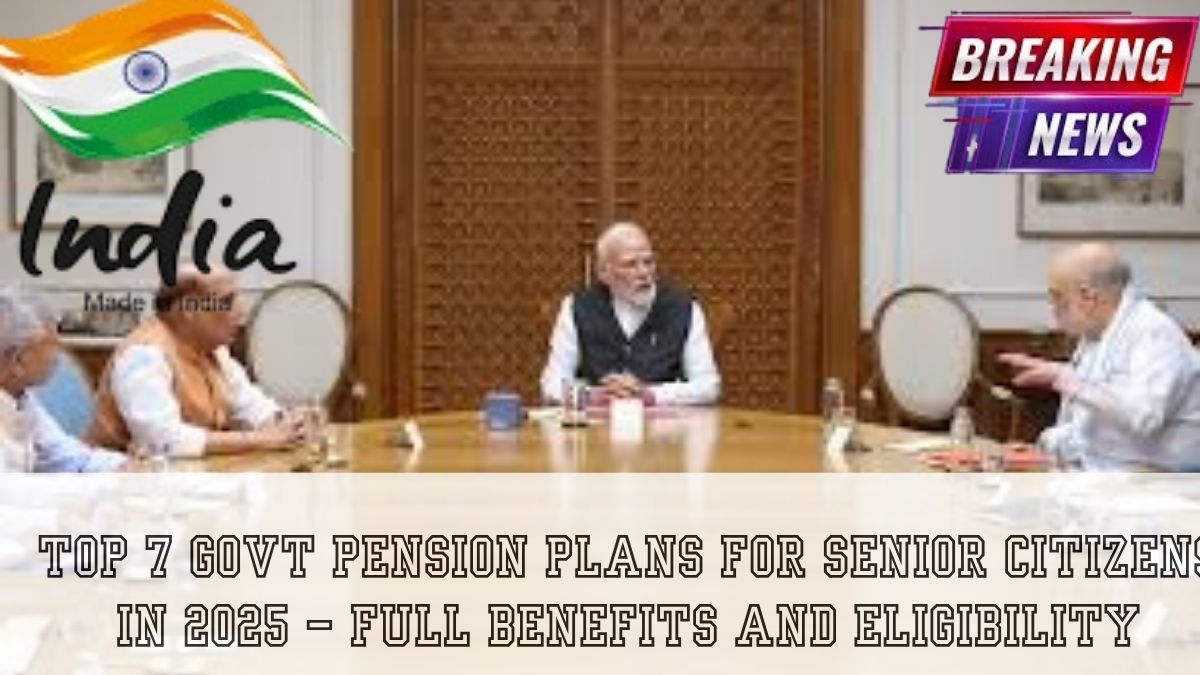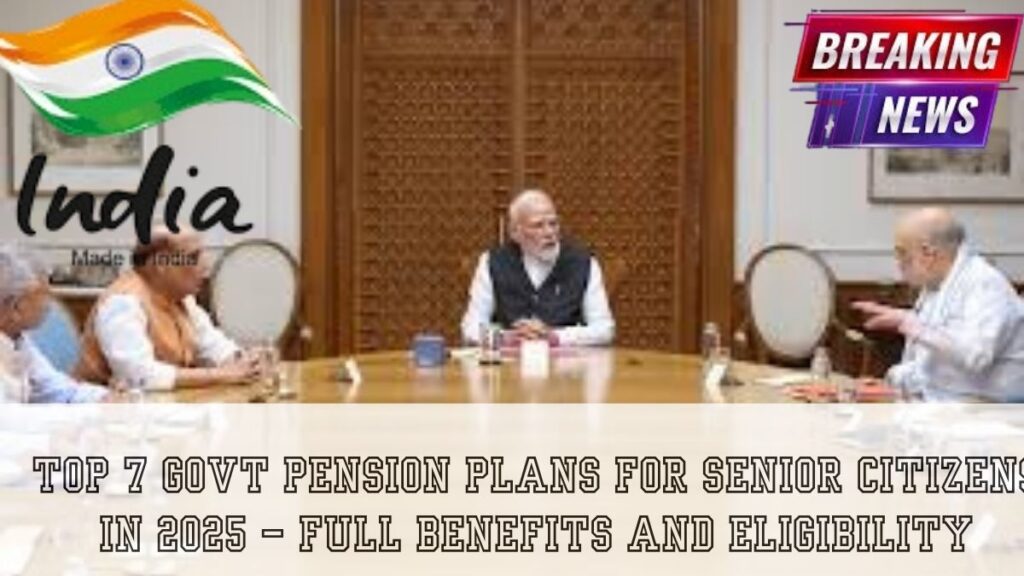As India’s aging population continues to grow, the government and financial institutions have introduced a wide array of pension plans to support financial independence for senior citizens. These plans are structured to offer regular income, reduce post-retirement financial stress, and ensure a dignified life for elderly citizens. With the arrival of 2025, it becomes vital to stay informed about available pension schemes and how to leverage them for maximum benefit.

Quick Summary Table
Aspect |
Details |
|---|---|
Purpose |
To provide financial security to senior citizens during retirement |
Key Schemes |
PMVVY, SCSS, APY, NPS, IGNOAPS, POMIS, LIC Jeevan Akshay, RBI Bonds |
Interest Rates |
6.6% to 8% for fixed plans; variable for market-linked schemes |
Eligibility |
Mostly 60+, some schemes allow 18+ (e.g., NPS, APY) |
Benefits |
Income security, tax deductions, insurance, low risk (in some plans) |
Best for Guaranteed Returns |
PMVVY, SCSS |
Tax Exemptions |
Available under Section 80C for select schemes |
Accessibility |
Most schemes available through banks, LIC, post offices, and online platforms |
Official Portal |
Overview of Senior Citizen Pension Plans
Pension plans for senior citizens in India are specially crafted to provide a stable income source during retirement. These plans are a mix of government-backed and market-linked options, enabling individuals to choose schemes that align with their income needs and risk tolerance.
Key Benefits of Pension Plans
-
Assured Regular Income: Most schemes offer monthly or annual payouts.
-
Tax Benefits: Some schemes provide deductions under Section 80C of the Income Tax Act.
-
Financial Independence: Reduces reliance on family members or external help.
-
Peace of Mind: Secure financial future ensures emotional well-being.
Detailed Comparison of Senior Citizen Pension Plans
Pension Plan |
Interest Rate / Return |
|---|---|
Pradhan Mantri Vaya Vandana Yojana (PMVVY) |
8% per annum |
Senior Citizen Savings Scheme (SCSS) |
7.4% per annum |
Atal Pension Yojana (APY) |
Varies (based on contribution) |
National Pension System (NPS) |
Market-linked returns |
Indira Gandhi National Old Age Pension Scheme |
Fixed Monthly Pension |
Post Office Monthly Income Scheme (POMIS) |
6.6% per annum |
LIC Jeevan Akshay |
Varies (annuity-based) |
RBI Floating Rate Savings Bonds |
7.15% per annum |
Eligibility Criteria for Senior Pension Plans
Understanding eligibility is critical to choosing the correct plan. These criteria may differ based on age, income level, and resident status.
Pension Plan |
Eligibility |
|---|---|
PM Vaya Vandana Yojana |
60 years and above |
Senior Citizen Savings Scheme |
60 years and above |
Atal Pension Yojana |
18-40 years, must be NPS subscriber |
National Pension System |
18-65 years, Indian citizen |
Indira Gandhi National Old Age Pension Scheme |
BPL, 60 years and above |
Post Office Monthly Income Scheme |
Minimum age 10 years |
LIC Jeevan Akshay |
Age between 30-85 years |
RBI Floating Rate Savings Bonds |
Resident Indian individuals |
Strategies to Maximize Pension Plan Benefits
To get the most out of these schemes, retirees should follow a multi-pronged strategy that considers diversification, regular review, and updated knowledge of financial policies.
Maximization Tips:
-
Diversify Investments: Allocate funds in a mix of government-backed and market-linked schemes.
-
Review Goals Regularly: Adjust investments as per changing retirement needs.
-
Stay Informed: Monitor updates and reforms related to pension schemes.
Comparative Analysis of Pension Plan Benefits
Benefit Type |
Applicable Plans |
|---|---|
Regular Income |
PMVVY, SCSS, POMIS |
Tax Benefits |
NPS, SCSS, LIC Jeevan Akshay |
Market-Linked Growth |
NPS, APY |
Government Guarantee |
PMVVY, SCSS, IGNOAPS |
Insurance Component |
LIC Jeevan Akshay |
Fixed Returns |
RBI Bonds, POMIS |
Flexibility |
NPS |
Accessibility |
IGNOAPS (especially for BPL individuals) |
Key Considerations When Choosing a Pension Plan
Choosing the right pension plan involves evaluating several critical factors. These ensure that the plan aligns with personal financial goals, risk appetite, and retirement needs.
Important Factors to Consider
Factor |
Details |
|---|---|
Interest Rate |
Higher rates enhance retirement corpus |
Risk Tolerance |
Market-linked plans involve variable returns |
Flexibility |
Plans like NPS allow withdrawal and re-investment options |
Tax Benefits |
Certain plans qualify for deductions under Section 80C |
Government Guarantee |
Ensures security and consistent income |
Tenure |
Short-term and long-term plans are available |
Eligibility |
Based on age, income status, and citizenship |
Payout Option |
Choose between lump sum or periodic payouts |
Official Government Portal
For complete and authentic information on all government pension plans:
Official Website: https://www.india.gov.in
Frequently Asked Questions (FAQs)
1. What is the minimum age to join the Senior Citizen Savings Scheme (SCSS)?
The minimum age is 60 years. For retired defense personnel, it is 55 years.
2. Are tax benefits available under these pension plans?
Yes. SCSS, NPS, and some LIC plans offer tax benefits under Section 80C of the Income Tax Act.
3. Can Non-Resident Indians (NRIs) invest in these pension schemes?
Generally, most government-backed pension schemes are for resident Indians only. However, some LIC and bank annuity products may allow NRI participation with specific terms.
4. Which is the safest pension plan with fixed returns?
The Pradhan Mantri Vaya Vandana Yojana (PMVVY) and the Senior Citizen Savings Scheme (SCSS) offer fixed returns with government backing, making them ideal for safety-focused retirees.
5. How should I choose the right pension plan for retirement?
Evaluate your financial goals, desired income stream, risk appetite, and compare interest rates, flexibility, and tax benefits across plans before deciding.
Conclusion
Planning for retirement in 2025 requires careful evaluation of India’s wide range of pension schemes. Whether looking for high security, fixed returns, or market-linked growth, there is a pension plan tailored to every senior citizen’s need. By understanding eligibility, benefits, and tax advantages, individuals can secure a comfortable, stress-free retirement and lead a financially independent life.
If you need assistance in comparing or applying for any of these schemes, consider consulting a certified financial advisor or visiting the official government portal: https://www.india.gov.in.
For More Information Click Here









